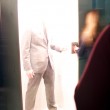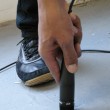Exit Through the Gift Shop – a Banksy film
Thinking I was about to see a documentary on Banksy, I eagerly attended the Los Angeles preview on April 7th. To my surprise and delight Exit Through the Gift Shop was a rolling conversation on the art market, celebrity and playing the role of artist demonstrating social networks and communal environmental interactions.
Exit Through the Gift Shop is the first feature film by Banksy ‘`a the story of how an eccentric Los Angeles based French shop keeper turned documentary maker attempted to locate and befriend Banksy whilst in the end only to have the artists turned the camera back on its owner’
The highly clever, elusive Banksy turns the camera onto his filmmaker Thierry Guetta who had unrestricted access to Banksy world of graffiti art and the world it commands. By asking Guetta to make a documentary is a matter of trust allowing him access into his secret world.
One of the many comic points in the film is when a door opens to a room filled with a massive amount of videotapes Guetta had collected over the years of documenting graffiti in action. Guetta was supposed to be producing a film about graffiti art and the parameters in regards to that but instead he culls the footage into this awful trailor type film that documents nothing on Banksy but instead uses all the effects in Final Cut Pro possible.
Taking command and reconverting the situation, Banksy in turn tries his hand at making a film. Banksy and Guetta swap roles. The artist asks the filmmaker to take on the role of artist while Banksy becomes the filmmaker.
The DIY aesthetic: Banksy and Mr. Brainwash
A successful artist takes on the right balance mix of the ingredients
How to create press and luck: being at the right place at the right time
Knowing how to market an event
Hype and humor: the translation to LA
Real art vs. the art market
Feeding frenzy
Banksy
What does it take and who is marketing it ?
Banksy is on the cover of the LA weekly this week.
In regards to seeing the premiere, it was a closed hush hush event leaving me lingering and wondering
I didn’t know where the screening was till the morning of.
Banksys’ show in 2006 in Los Angeles Bareley Legal was attended by many Hollywood celebrities. 75,000 people were in attendance in merely 3 days. He includes the literal tongue in cheek joke of the pink elephant in the room and that is what he shows the press covering in Exit through the Gift Shop.
Mr. Brainwash
Mr. Brainwash’s show concerned himself with the hype.
Banksy mocks the people in line at the Brainwash show
to make it meaningless exactly what Hollywood does and Banksy showing Hollywood the DIY marketing is ultimate validation for Banksy and ultimate validation is exactly what Mr. Brainwash was trying to pull off by having such a huge event such as his show,
Suckers buying in
Buying up the 200 pieces in Mr. Brainwash’ show
The Hollywood folks spray painting a truck outside the premiere
It takes a French guy and an English guy to mock American LA
Sociology
Interestingly enough no on in my audience at the Los Angeles premiere of Exit through the Gift Shop laughed at Banksy’s mockeries of the art crowd at both Mr. Brainwash’s and Banksy’s show Barely Legal.
Exit Through the Gift Shop illuminates both Mr. Brainwahs’s show and Banksy’s Barely Legal raising the question Art is a joke? or the joke is on us?
A strong work of art is one that leaves you questioning while raising questions and is still open for interpretation on many levels and layers and fits in to all.
Banksy creates his work out of belief while Mr. Brainwash absorbs his environment and is seeking valuation. When asked in the movie “Is this what you do for a living?” Thierry answers “It’s my passion I live for my passion “. He is passionate enough to put his home and equity and security of wife and children on the line to produce his show.
He raises the questions is Mr. Brainwash being brainwashed or is he brainwashing the public?
It’s all about the reaction
Audience reaction
Endurance art without the authenticity?
Trying to create a reaction without the passion.
The goers outside Mr. Brainshwash show being interviewed: Not even knowing why they are there. being brainwashed by him or by celebrity culture?
Trying to grasp a hold of something ….
Thierry employed 20 people to produce his his event as well as the art makers of his 200 paintings and sculptures for the show.
Authenticity is cheap.
Reconfirming the spectacle
Put down your camera and become a street artist were the words of Banksy.
Thierrey changes his role after watching street art which is a comment of artist being absorbed by the experience.
Ironically, Banksy ended up making an art star out of his previous filmmaker throughpromoting him whereas originally Guetta was supposed to be shedding light on the Graffiti world and promoting Banksy. The irony is Mr. Brainwash’s work sells for almost double what Banksy work does these days.
Even Madonna, who also knows how to market and hype jumped right in on this spectacle and had Mr. Brainwash do the cover of her Celebration album.
Superimpose yourself and disseminate
Artist as entrepreneur : the DIY aesthetic is highly profitable when you know how to command attention
Real power from perceived power to attract attention by remaining elusive and attracting attention to the film.
An artist’s translation of documentary into biting sarcasm of the joke is on whom?
Subverting reality on one hand but making it public on another
The question remains what are you after?
Performance Spectacle: the main event
Private preview of Exit Through the Gift Shop Los Angeles Theatre April 12th
The stage: downtown LA
The Hollywood film world stands about
Camera flashing on red carpet
Like a disco ball
Performance spectacle
Free drinks and popcorn
Cocktail servers in flapper outfits and ski masks
I went back for second time not for the film I went for the spectacle of the crowd through the eyes of a performance artist in the role of editor
Learning and absorbing as I still find myself pondering the title
Black guy in black thin framed glasses in 70’s striped robe taupe yellow and brown vertical stripes; same one as he wore a week ago at the preview
Who are you I had to wonder? and what role am I playing tonight?
The film promises an incredible insight into Banksy’s world is that why at the screening there was double security first giving your name had to be on the guest list and then you needed a wristband once inside the theatre that no usher actually checked to see if you were wearing
Was this to ensure Banksy’s reaffirmation that even the screening was most definitely a circus?
Complete with popcorn but where are the circus peanuts I might ask
Old ragtime playing in the vintage theatre
Film art London L.A performance
A young male Hollywood P.A, who had just finished his first novel, asked me
“How do you feel about Banksy as an artist?”
I replied with “how does this differ from a Hollywood premiere?”
All I could think was you are now part of Banksy’s art, you are in the center of the spectacle
To command attention: keep a captive audience with green wristbands to gain entry into this private event/spectacle screening
Myself as artist in audience of film
What hat am I wearing?
What city am I in?
and
What is this incredible connection between Los Angeles and London
Art world vs. film world
Banksy is a performance artist and his PR tactics fit LA perfectly
Putting it over the top and raising a multitude of questions
An artist is always breaking the rules and creating his/her new ones
Obey
Brainwash
Promote
By making this film Banksy is declaring street art is dead hence why we have Juliette Lewis being photographed by Pop Sugar while graffiting the truck outside the premiere.
Standing on the red carpet
spray-painting a couple of vans
to find your Hollywood glitch niche American pop up mart
In the end, I departed my first red carpet event deciding to remain elusive like Banksy.
I returned to fetch my beat up pick up truck in its $5 parking lot …tank on empty
No limo or valet for this artist
Need gas
Ironically my initials are G.A.S
Out of gas?
To see how far I can get thus pushing the boundaries a little further
A rat wandered under a parked car in the downtown lot
I could only think Banksy the elusive, artist continues to reinvent himself as magic abounds in the streets of downtown L.A.
Alex Staiger
Los Angeles Editor, Artcards
www.alexstaiger007.com

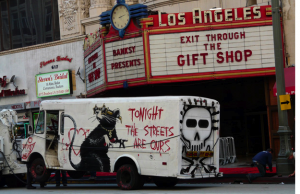
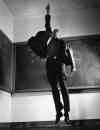

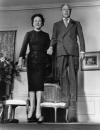
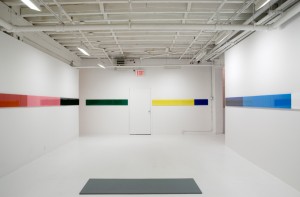
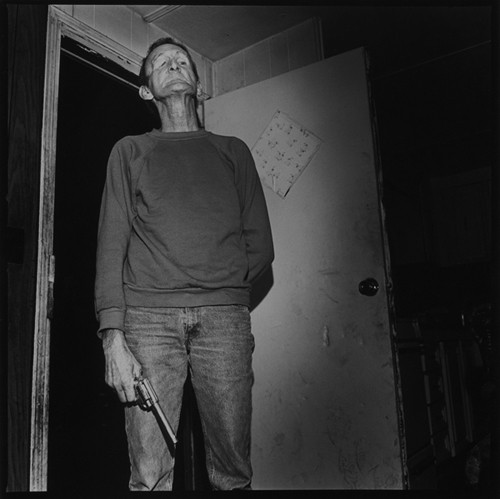
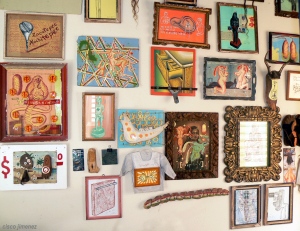

 RSS
RSS